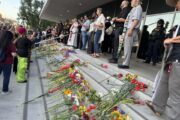This USC News article was built off of a source alert “Spirituality in a Pandemic: A Test of Faith for Believers and Organizations.” The source alert has additional perspective from Najuma Smith-Pollard and Donald E. Miller.
After closures affected over 90% of religious services in April, houses of worship are slowly reopening. Recent surveys show more than half are operating with coronavirus-related modifications, with some of those observing few restrictions.
Nevertheless, conflicts between congregations that want to gather and government entities pressing health-related restrictions persist.
“What is needed now is leadership from the public sector to communicate clearly under what conditions houses of worship can open safely,” said Brie Loskota, executive director of the Center for Religion and Civic Culture at the USC Dornsife College of Letters, Arts and Sciences.
“Many people shape their lives around what they believe. They are more likely to turn to religious organizations for guidance and resources during times of crisis than their local councilperson’s office,” she added.
The pandemic is also forcing some churches to reimagine themselves, according to Richard Flory, the center’s director of research.
“Most churches have figured out how to deliver their Sunday services via digital means. The most creative are listening to their communities — both their members and the larger communities they serve — and adapting their ministries and programming to meet emerging needs within the new limitations the COVID-19 pandemic has placed on them,” he said. “To put this in somewhat Darwinian terms: only the smart, adaptive, resourced or opportunistic will survive.”
For some faith-based institutions, pandemic offers room to grow
While regular services can be moved online, traditional rites of passage like weddings, funerals and bar mitzvahs have largely been postponed. Those uninterested in religion, considered to be about 25% of the U.S. population, remain unmoved.
But there is room for growth, according to Diane Winston, Knight Chair in Media and Religion at the USC Annenberg School for Communication and Journalism.
“Over the last few months, people are praying and meditating,” she said. “People pray all the time — for love, money and parking spots. But now many are praying for an end to the pandemic, the health of family and friends, and the money to pay their bills. Downloads of mediation apps like Headspace are booming. There also is an increase in mindfulness classes and sessions.
“The second area of growth is memorializing the dead. Zoom — while bringing together far-flung relatives and friends — lacks the high-touch immediacy that mourners crave.”
Healing justice amid dual pandemics
The summer of 2020 will be remembered for mass demonstrations, with masked protestors carrying banners and signs for the Black Lives Matter movement.
“A significant aspect of the organization’s work involves direct service to communities directly impacted by state violence, said Hebah Farrag, assistant director of research at USC Dornsife’s Center for Religion and Civic Culture. “The movement’s deep embeddedness often goes unnoticed. For example, Dignity and Power Now in Los Angeles successfully agitated on behalf of prison populations facing COVID-19 while ensuring health access and testing sites for communities directly impacted by state violence.
“Black Lives Matter chapters and affiliated groups have become critical social infrastructure for communities battling the dual pandemics of racism and COVID-19.”






